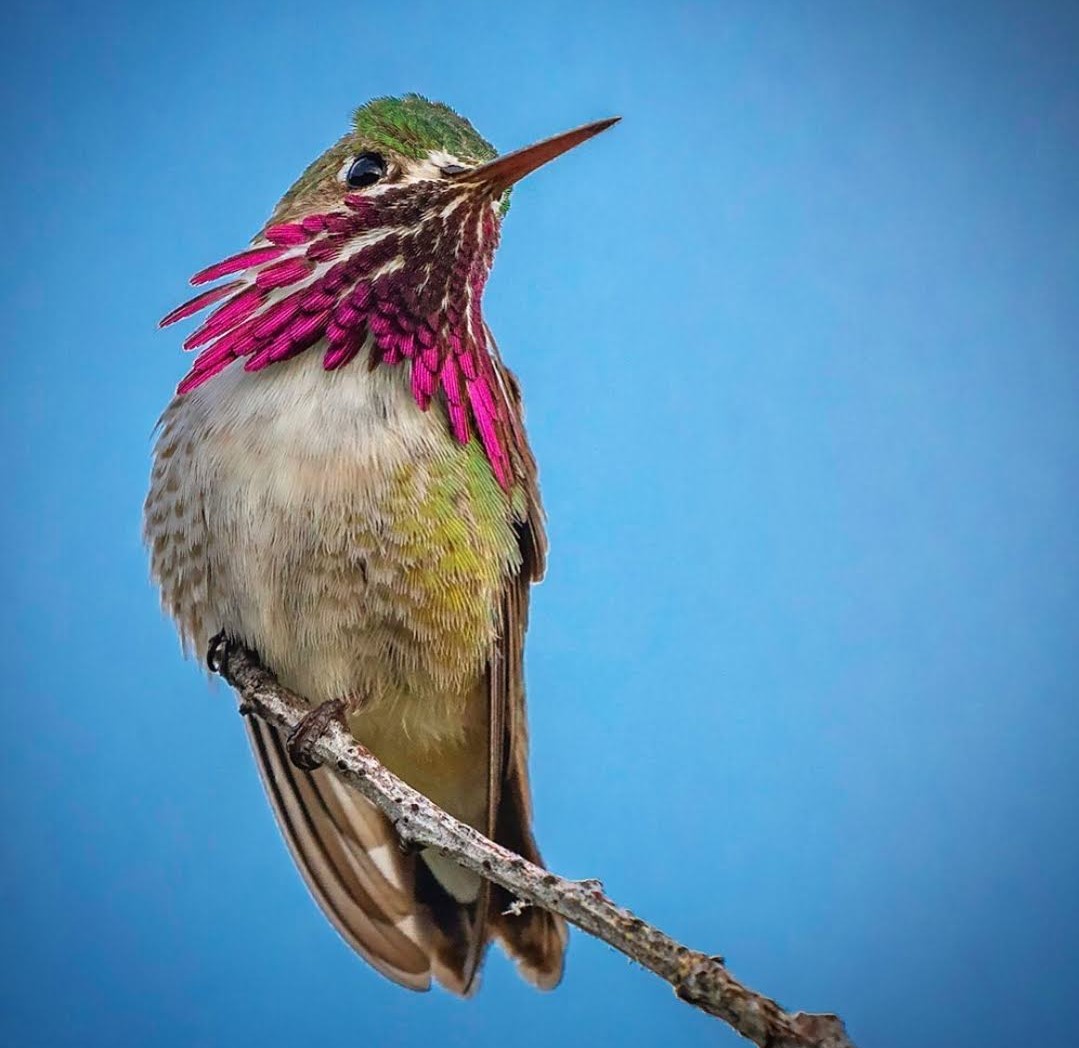This post contains affiliate links.
What types of hummingbirds are found in Idaho?
- There are 8 hummingbird species found in Idaho.
- Anna’s – (Calypte anna)
- Black-chinned – (Archilochus alexandri)
- Broad-tailed – (Selsaphoris platycercus)
- Calliope – (Selasphorus calliope)
- Rufous – (Selasphorus rufus)
- Ruby-throated – (Archilochus colubris)
- Broad-billed – (Cynanthus latirostris)
- Costa’s – (Calypte costae)
Idaho, known as the Gem State, is home to hummingbirds that are both year-round and seasonal. There are even some hummingbird species found in Idaho that are considered exotic rare visitors.
While it is easy to assume all hummingbirds are the same when we see them only as a jewel-toned flash of color as they jet around our hanging flowers and porches; they have different temperaments, varied nesting habits, diverse coloring and reside in multiple geographical ranges.
There are 3 categories of hummingbirds found in Idaho. Year-round natives, seasonal, and rare hummingbirds.
Hummingbirds are known to exist within certain established ranges, either as year-round natives or as part of a migratory cycle.
While there are species of hummingbirds that are year-round natives to Idaho as well as seasonal visitors, there are hummingbirds rarely found in Idaho that show up at feeders far outside their established range. These hummingbirds are known in ornithological circles as “vagrants.”
Categories of Hummingbirds:
Year-Round/Native Hummingbirds:
These hummingbirds live in Idaho year-round.
- Anna’s (Year-Round Native/ Overwintering)
Seasonal Hummingbirds:
These hummingbirds are in Idaho temporarily as part of their migratory pattern.
- Black-chinned (Seasonal – Migrate)
- Broad-tailed (Seasonal – Migrate)
- Calliope (Seasonal – Migrate)
- Rufous (Seasonal – Migrate)
Rare/Vagrant Hummingbirds:
These hummingbirds are outside of their normal geographic range when found in Idaho but are occasionally spotted. Not only do these species of hummingbirds have a wide variety of specific geographic ranges, but they are also known to sometimes interbreed with each other, creating hybrids.
- Broad-billed – (Rare-Accidental)
- Costa’s – (Rare-Accidental)
- Ruby-throated – (Rare-Accidental)
Because of human intervention, in the form of feeding stations and the transplant of exotic flowers in residential areas, some hummingbirds in mild climates are staying rather than migrating.
Read on to find out more about each of these hummingbird species as well as where and when they can be found in Idaho.
Year-Round/Native Hummingbirds
ANNA’S HUMMINGBIRD – (Calypte anna)
Conservation Status: Least concerned
Kingdom: Animalia
Phylum: Chordata
Class: Aves
Order: Apodiformes
Family: Trochilidae
Genus: Calypte
Species: C. anna
Anna’s hummingbirds are named after Anna Massena, Duchess of Rivoli. Anna’s hummingbirds have become a new winter visitor to Idaho.
According to Boise State University, their IBO research team (Intermountain Bird Observatory) has recently identified Anna’s hummingbirds as a year-round hummingbird to Idaho, especially in Ada County. Through the practice of banding, they have identified an adult male Anna’s hummingbird near New Meadows that stayed all winter in temperatures as low as -10 degrees Fahrenheit. This makes the first discovery of a hummingbird that can or does over-winter in Idaho.
Boise State has also confirmed their first documentation of an Anna’s hummingbird nest in southeast Boise, Idaho, taken in July of 2020.
Male Anna’s hummingbirds are the only hummingbird species in North America with a red crown. They are identified as mostly green, gray, and magenta in color. The males have a flashy and colorful iridescent magenta gorget and crown. Their size ranges from 3.5 inches to 4.3 inches in length and they weigh 2.4 to 4.5 grams.
The gorget on a male hummingbird is named after the protective metal piece in a suit of armor that covers the wearer’s throat to prevent injury when in battle. Since male hummingbirds are very aggressive with each other when fighting for their own territory, this name is appropriate and fitting to describe their physical attributes.
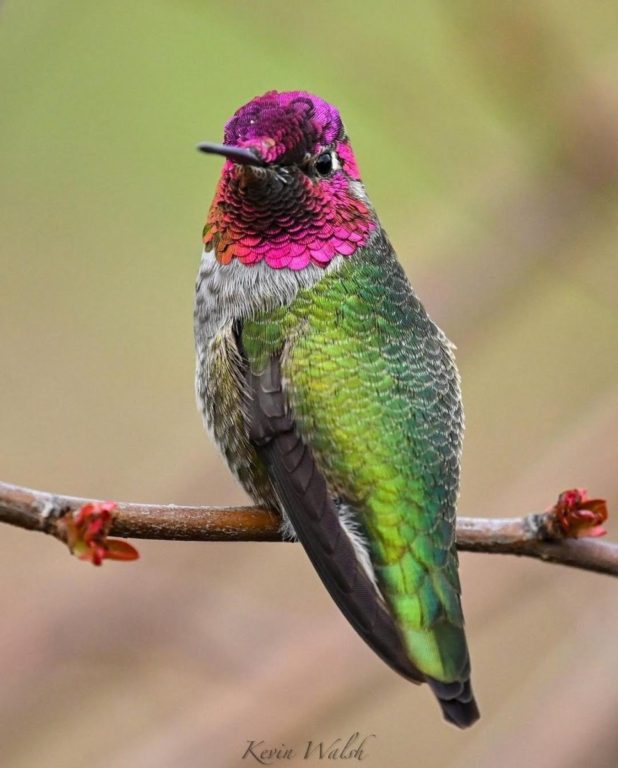
Photo by: Kevin Walsh
Note: The iridescent magenta gorget and crown with a metallic green shiny back.
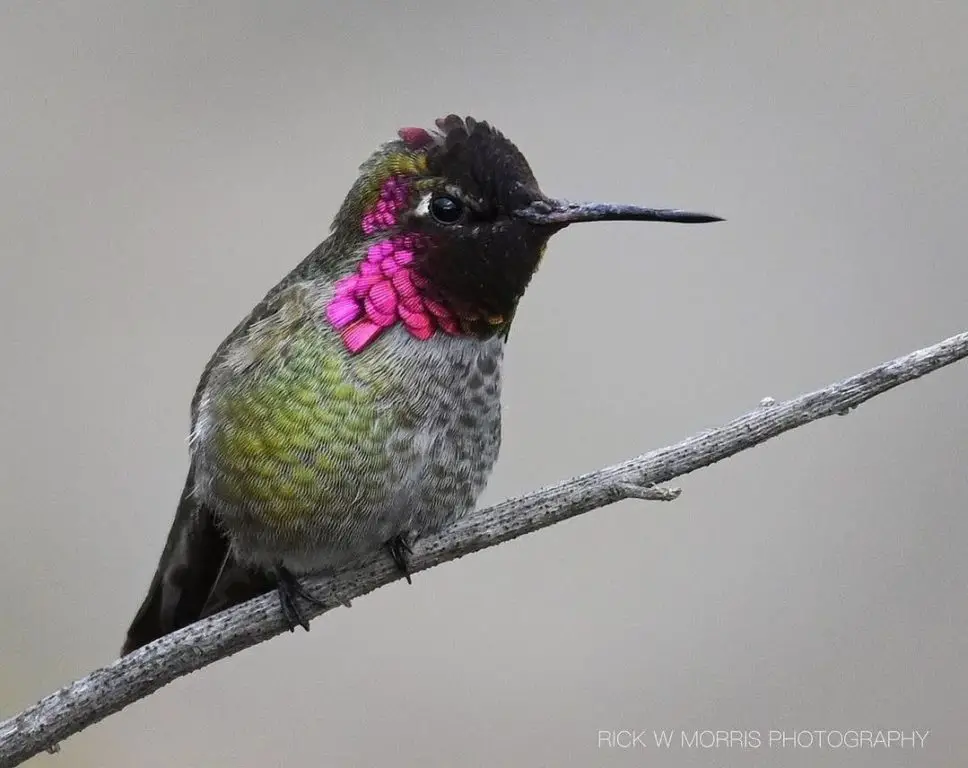
Photo by: rickwmo
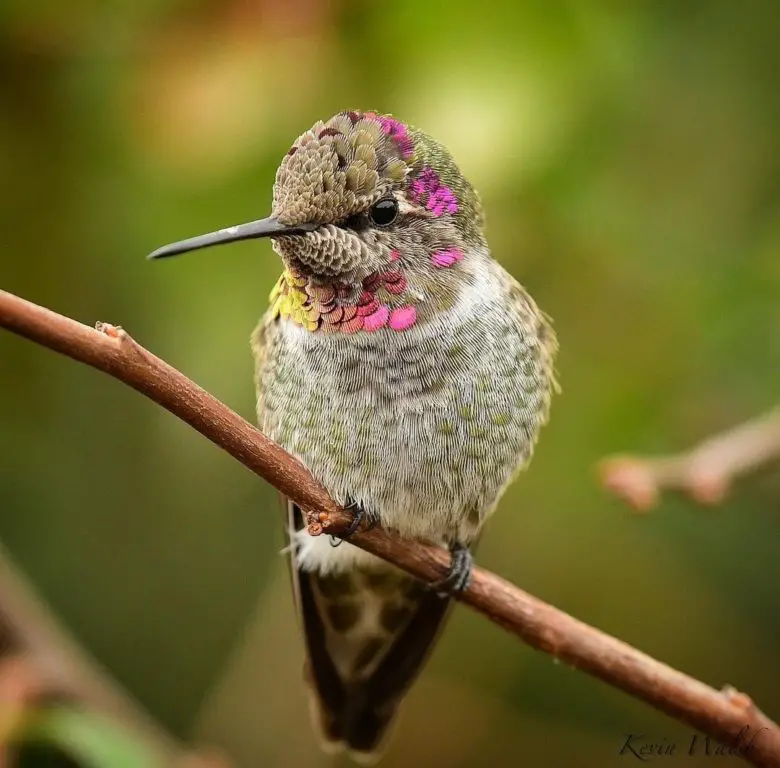
Photo by: Kevin Walsh
Note: This Anna’s hummingbird could be a juvenile in those awkward teenage years or it could be during a molting stage.
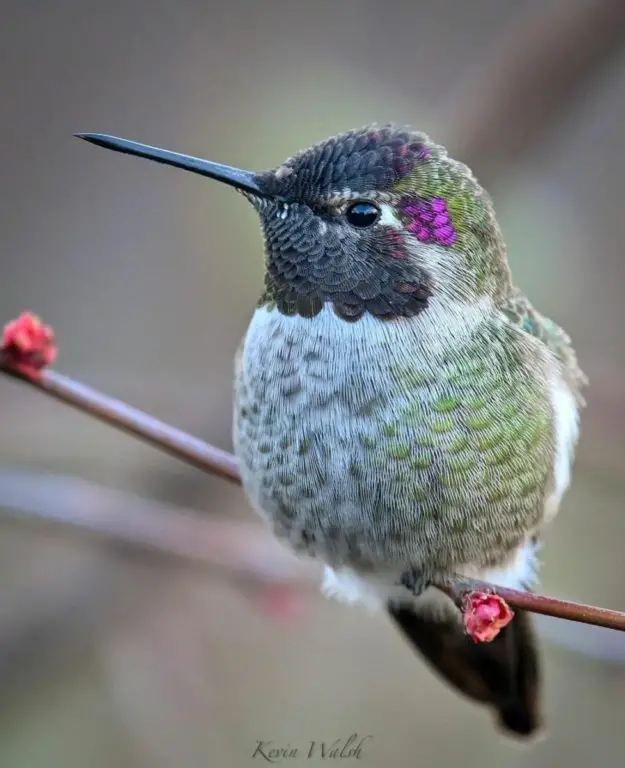
Photo by: Kevin Walsh
Note: This Baby/Juvenile Male Anna’s Hummingbird is beginning to show his magenta head feathers near his temple along with some faint color starting to show on his gorget.
Female Anna’s hummingbirds are overall not as colorful as the males, appearing pale green in color. Females can also have a gorget, but it is a smaller patch of magenta. Females tend to have a pale white line over each eye that makes them distinctive.
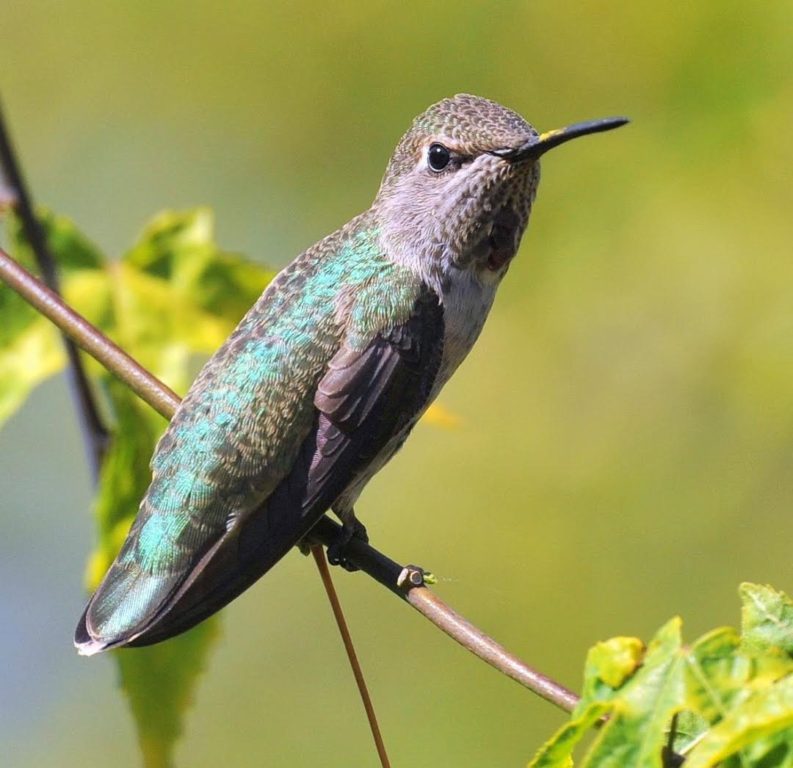
Photo by: rickwmo
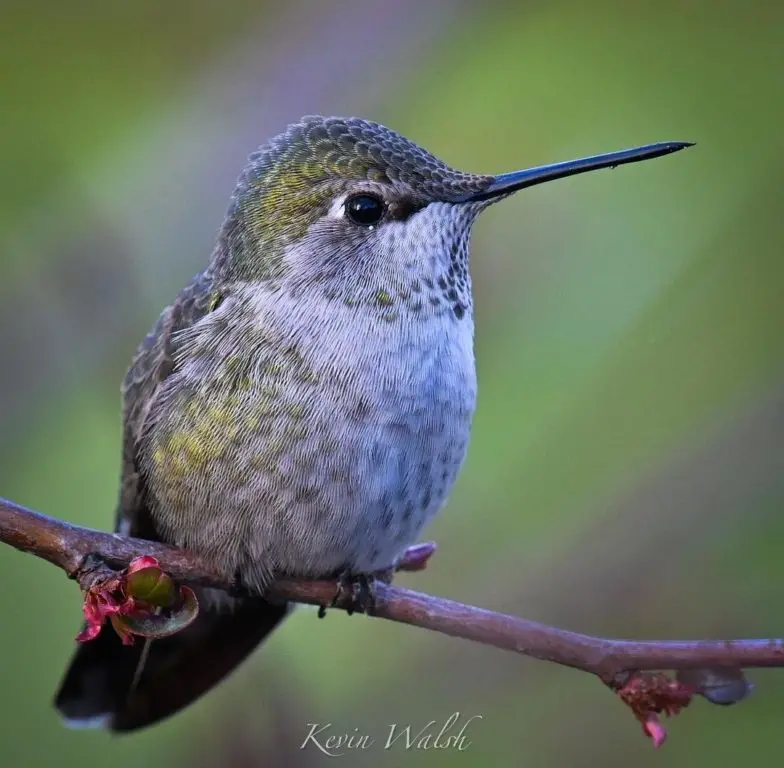
Photo by: Kevin Walsh
The Anna’s hummingbird predominantly breed in northern Baja California and parts of Southern California, however, due to the transplanting of exotic ornamental plants in residential areas along the Pacific Coast and Inland Deserts, their breeding range has expanded up the Western Seaboard. Anna’s hummingbirds have the northernmost year-round range of any hummingbird species.
Female Anna’s hummingbirds raise their young with no help from the males.
Anna’s hummingbirds protect their territory with elaborate dives targeted towards predatory birds and even towards people they perceive to be threatening.
See pictures of male, female and juvenile Anna’s hummingbirds here…..
Hear sounds of Anna’s hummingbirds here…..
Seasonal Hummingbirds
BLACK-CHINNED HUMMINGBIRD – (Archilochus alexandri)
Conservation Status: Least concerned
Kingdom: Animalia
Phylum: Chordata
Class: Aves
Order: Apodiformes
Family: Trochilidae
Genus: Archilochus
Species: A. alexandri
Black-chinned hummingbird’s scientific name is in commemoration of Dr. Alexandre, a French doctor who was the first to discover the species in Mexico.
According to the United States Department of Agriculture (USDA), Black-chinned hummingbirds are a common summer breeding resident to Idaho.
Kootenai National Wildlife Refuge documented Black-chinned hummingbirds migrate to Kootenai to breed during spring and summer migration.
Male Black-chinned hummingbirds are identified by their royal purple gorget, showing a small glimmer of color right near the neckline like a buttoned-up shirt. Since the male purple gorget or throat color is minimal, at times they can appear to look all black. They have metallic green on their backs and flanks with white on their underbelly. Their dark tail is forked and their bill is black. Their size is 3.25 inches to 3.5 inches in length and weigh 2.8-5.6 grams.
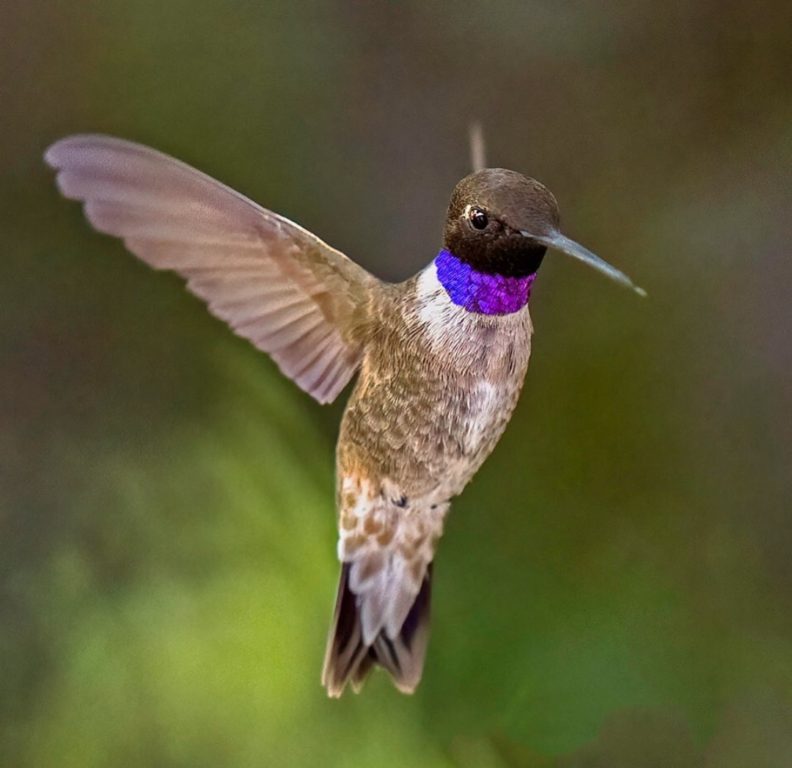
Photo by: sony_alpha_male
Taken: Boise, Idaho
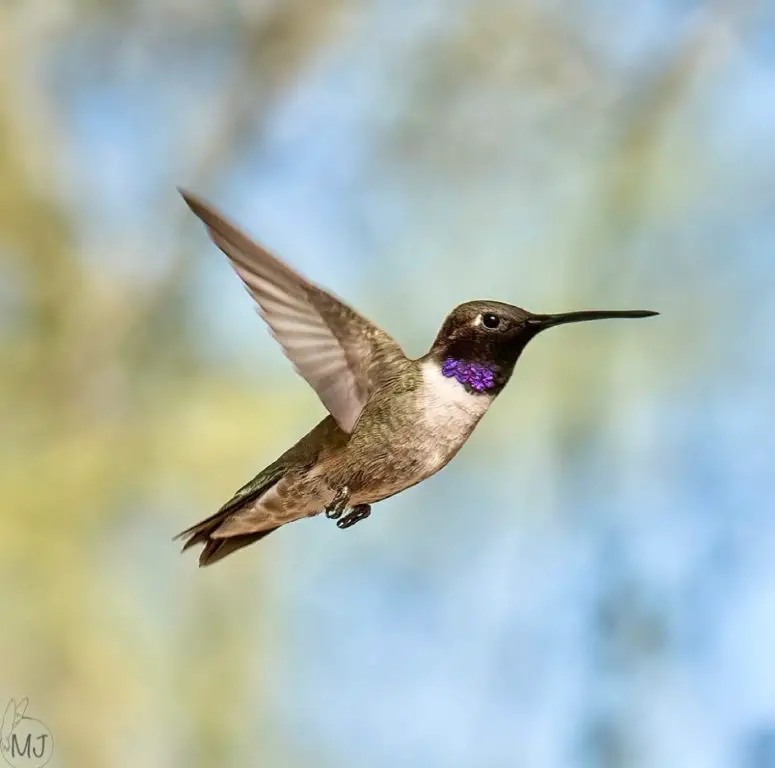
Photo by: hummingbirdsbysurprise
The gorget on a male hummingbird is named after the protective metal piece in a suit of armor that covers the wearer’s throat to prevent injury when in battle. Since male hummingbirds are very aggressive with each other when fighting for their own territory, this name is appropriate and fitting to describe their physical attributes.
Female and juvenile Black-chinned hummingbirds have no gorget, but have a dark rounded tail with white tips and beige margins on the dorsal feathers that turn dark black as they mature. Their head and back reflect the dull metallic marbled colors of beige, greens, whites, yellow-green and dark browns, looking similar to the scales found on a snake.
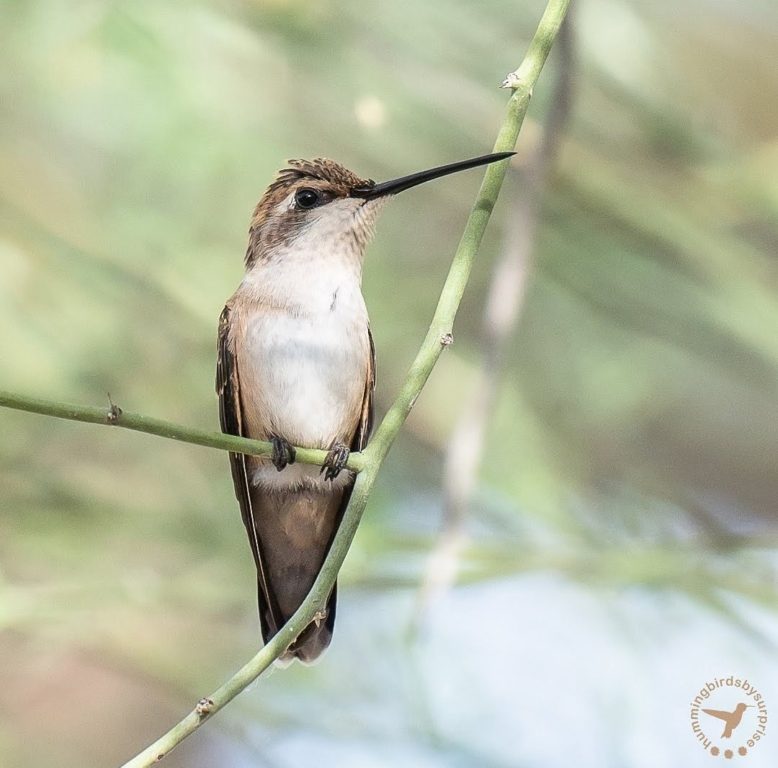
Photo by: hummingbirdsbysurprise
Black-chinned hummingbirds breed east of the Cascade mountain range and are a summer resident to Idaho. Their breeding grounds and habitat are closely related to their cousin counterparts, the Ruby-throated hummingbird.
They hybridize and readily crossbreed with other hummingbird species. Black-chinned hummingbirds can live up to 10 years, which is extremely long in comparison to other birds and animals of similar size.
Because of their small size, Black-chinned hummingbirds are at risk of being preyed-upon by larger insect-eating birds or larger insects such as a praying mantis. Black-chinned hummingbirds are known to use a decoy strategy by constructing their nest near larger and more active bird’s nests reducing the chance of predators around their nest.
See my article: 10 Common Things That Kill Hummingbirds
While typically a territorial species, if Black-chinned hummingbirds find themselves in an area with a large population of hummingbirds and food sources of plenty, their territorial behaviors will reduce and they will play nice and share.
Black-chinned hummingbirds have the smallest known genetic material of all living vertebrates or mammals.
See pictures of male, female and juvenile Black-chinned hummingbirds here…..
Hear sounds of Black-chinned hummingbirds here…..
BROAD-TAILED HUMMINGBIRD – (Selsaphoris platycercus)
Conservation Status: Least concerned
Kingdom: Animalia
Phylum: Chordata
Class: Aves
Order: Apodiformes
Family: Trochilidae
Genus: Selsaphoris
Species: S. platycercus
The Broad-tailed hummingbird, though usually residing in Mexico and Guatemala during the winter, is a common summer breeding resident to Idaho.
They have a migrant and non-migrant population that begins in the south of Mexico. The ones that migrate north to breed will do so during spring migration and will pass through Arizona, Colorado, Wyoming, Idaho and reach as far north as Montana.
Once the breeding season is complete, Broad-tailed hummingbirds once again depart and begin their southbound fall migration to Mexico in September to winter and meet up with their non-migrant population.
Male Broad-tailed hummingbirds have an iridescent ruby-red gorget. Both males and females have green topside and pale underbellies with bright white eye rings and broadly rounded tails. Their size is medium build and ranges from 3.3 inches to 3.8 inches in length and weighs 3.6 grams.
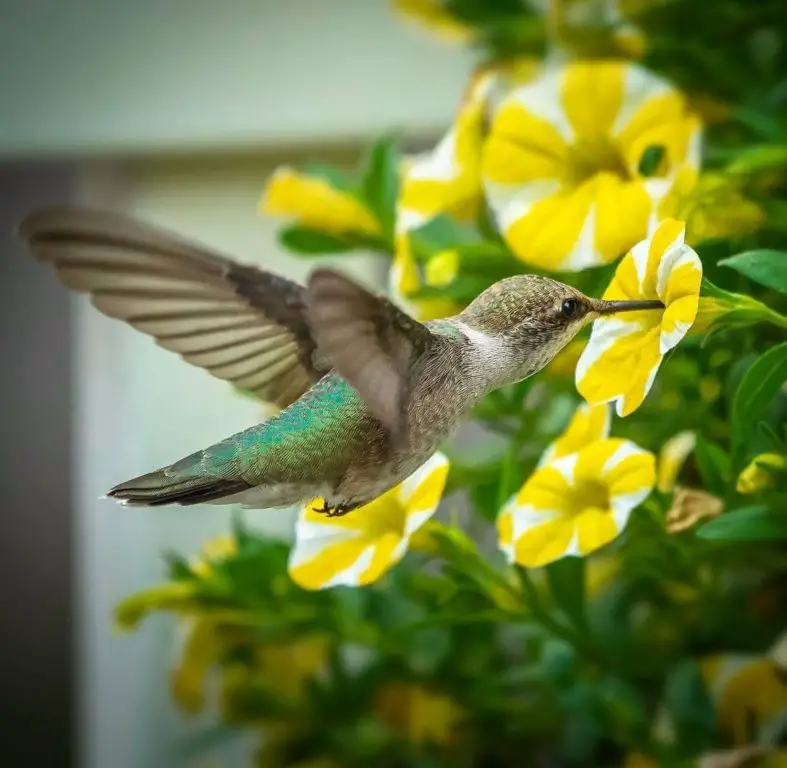
Photo by: sony_alpha_male
Taken: Boise, Idaho
This species of hummingbird favors habitats in the understory of mature forest woodlands such as pine and oak groves. They chose to nest on the branches of trees and have been known to return to the same nesting ground each year, roughly 70% of the time.
Their breeding time coincides with the peak time of flowering native plants for maximum food resource availability. Their favorite nectar producing flower plants include: Red Columbine, Indian Paintbrush, Sage varieties, Currants and Scarlet mint.
Broad-tailed hummingbirds commonly nest in Idaho during the summer. Their nests are often located over riparian corridors.
They are promiscuous and do not form any kind of a pair bond between male and female birds and again the female raises the young alone.
The Broad-tailed hummingbird has suffered a decline in population since the 1990s, but presently, its population is stable, and it has been shown to have adapted to human habitat encroachment.
See pictures of male, female, and juvenile Broad-tailed hummingbirds here…..
Hear sounds of Broad-tailed hummingbirds here…..
CALLIOPE HUMMINGBIRD – (Selasphorus calliope)
Conservation Status: Least concerned
Kingdom: Animalia
Phylum: Chordata
Class: Aves
Order: Apodiformes
Family: Trochilidae
Genus: Selasphorus
Species: S. calliope
Calliope hummingbirds are named after a Greek mythological muse, who represented poetry and eloquence. Calliope means “beautiful voice” in ancient Greek.
They are a seasonal common summer migrant to Idaho and are seen mostly in the mountains, arriving in the spring as early as April and leaving by mid-October. The rest of the time they winter in Mexico.
Male Calliope hummingbirds are easily identified by their iridescent purple crown and long striking spaced outline row of feathers that project down the sides of their throat. Like many hummingbirds the backs are metallic green and these birds measure 3 inches in length and weigh 2-3 grams.
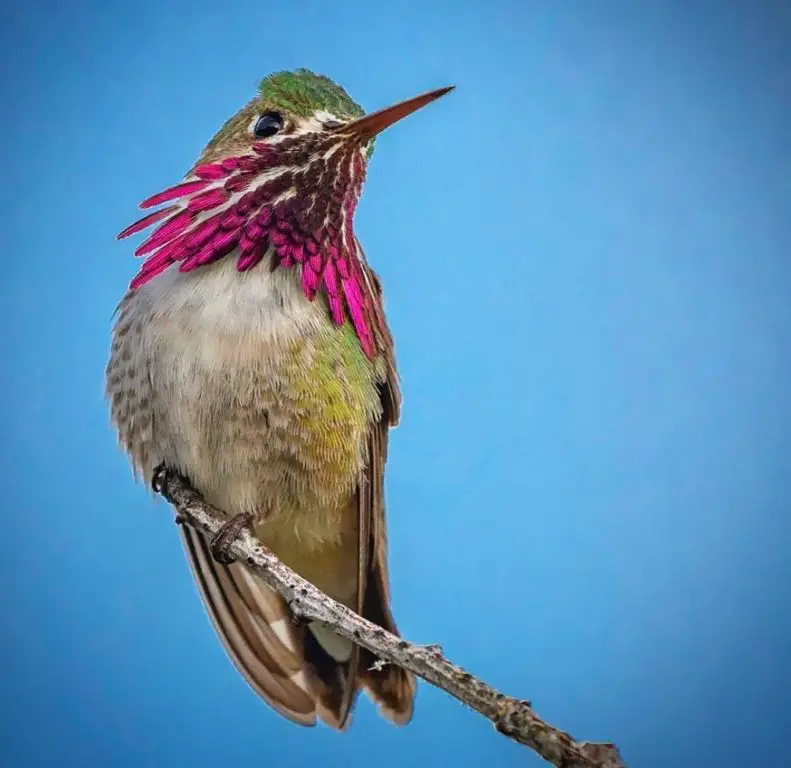
Photo by: sony_alpha_male
Taken: Boise, Idaho
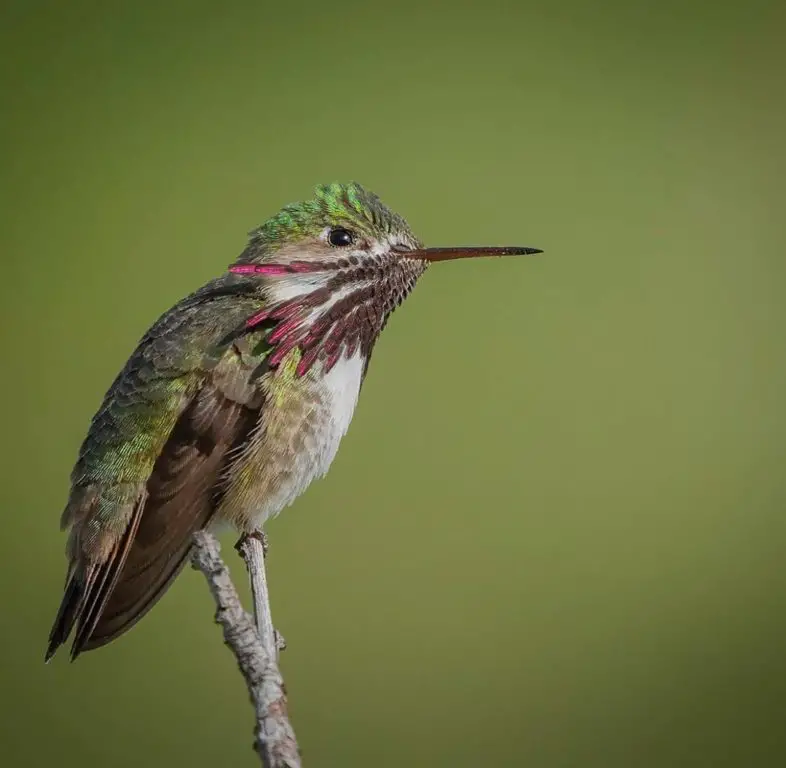
Photo by: sony_alpha_male
Taken: Boise, Idaho
Note: His bright throat feathers are slowly coming in.
Female Calliope hummingbirds have gray-green crowns and buff-colored flanks which are the underbelly or wing of a bird. Females sport dark tails with white tips.
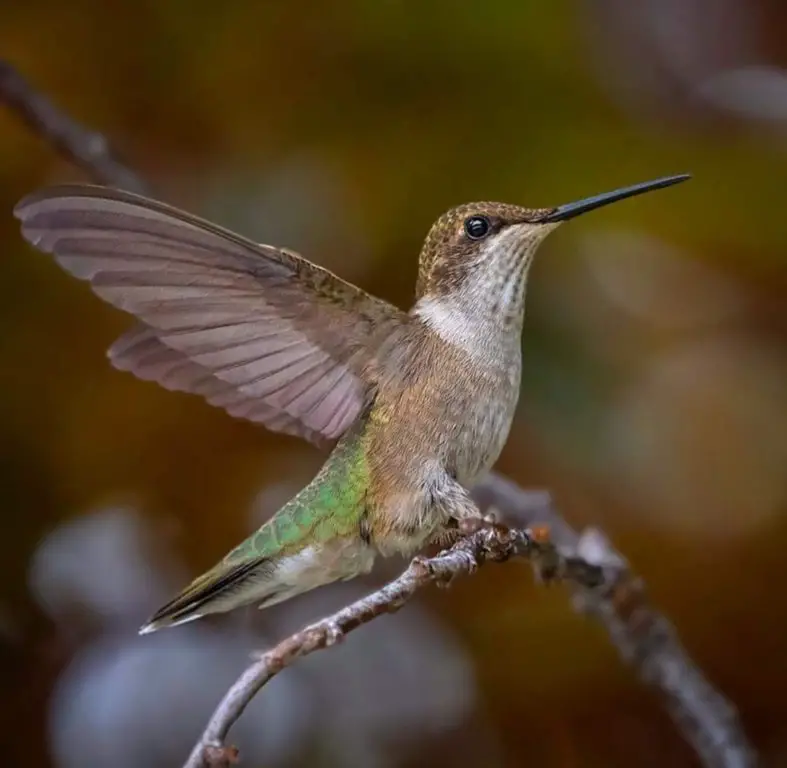
Photo by: sony_alpha_male
Taken: Boise, Idaho
Calliope hummingbirds are the smallest long-distance migratory bird in the world. They tend to breed in the higher elevations of the Rocky Mountains.
Like many hummingbirds, Calliopes communicate not just by their song, but also by manipulating their feathers during flight to make different buzzing noises that act as a form of language and communication.
Male Calliope hummingbirds establish a breeding territory and mate with every available female hummingbird that accepts his courtship.
During nest construction, the female Calliope chooses tops of pine cones as her building site. She will also dismantle nests from previous seasons and recycle them in her new nest along with stealing materials from the nests of other birds in order to construct her own.
Therefore, female Calliopes are often chased and attacked by larger and more aggressive hummingbirds such as Allen’s and Rufous hummingbirds. To avoid these attacks, the Calliope maintains a relatively low profile in comparison to other species.
Because Calliope hummingbirds have a more restricted wintering range than most hummingbirds, they are particularly vulnerable to habitat loss and natural disasters, such as climate change and wildfires.
During a capture and release banding operation in Idaho, the oldest living recorded female Calliope hummingbird was 8 years and 11 months old when she was captured twice, once in 2007 and again in 2014.
See my article: 3 Reasons Why Hummingbirds Are Banded
See pictures of male, female and juvenile Calliope hummingbirds here…
Hear sounds of Calliope hummingbirds here…..
RUFOUS HUMMINGBIRD – (Selasphorus rufus)
Conservation Status: Near threatened
Kingdom: Animalia
Phylum: Chordata
Class: Aves
Order: Apodiformes
Family: Trochilidae
Genus: Selasphorus
Species: S. rufous
The Rufous hummingbird gets its name from the Latin word rubrum meaning “red” that is used to describe its reddish-brown coloring.
They are a common summer breeding resident to Idaho. They breed in the northern 75% of Idaho. By mid-October, they leave and migrate south to over-winter in Mexico.
Male Rufous hummingbirds display an iridescent orange-red gorget with rusty-colored flanks and tail. They have a white to beige underbelly and a black bill. Males can also have green plumage with specks of green color on their rustic looking backs or on the crown of their head along with chocolate brown dorsal feathers. Their size is 2.8 inches to 3.5 inches in length and weighs 3.2 grams.
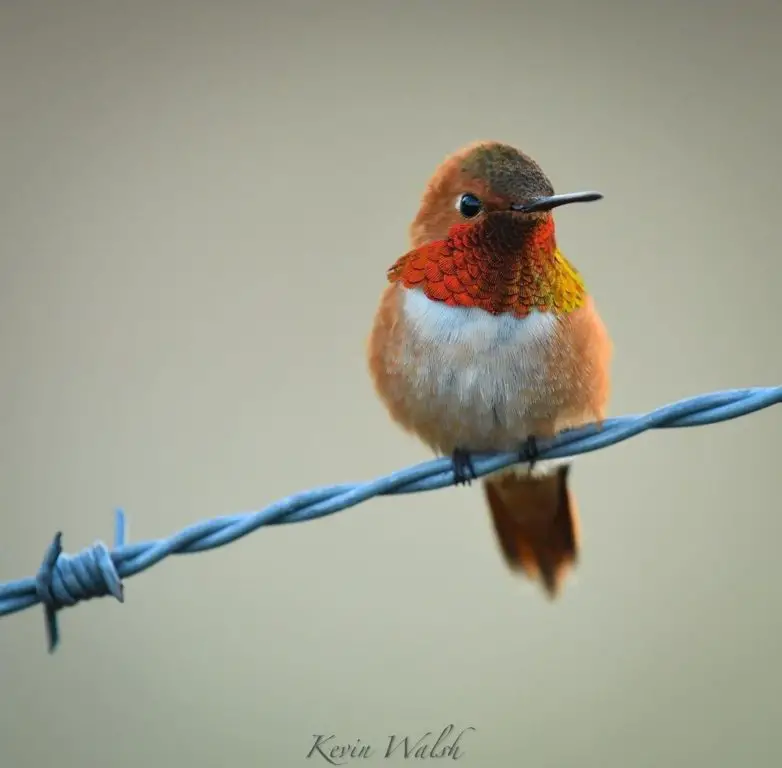
Photo by: Kevin Walsh
Note: The iridescent orange-red gorget.
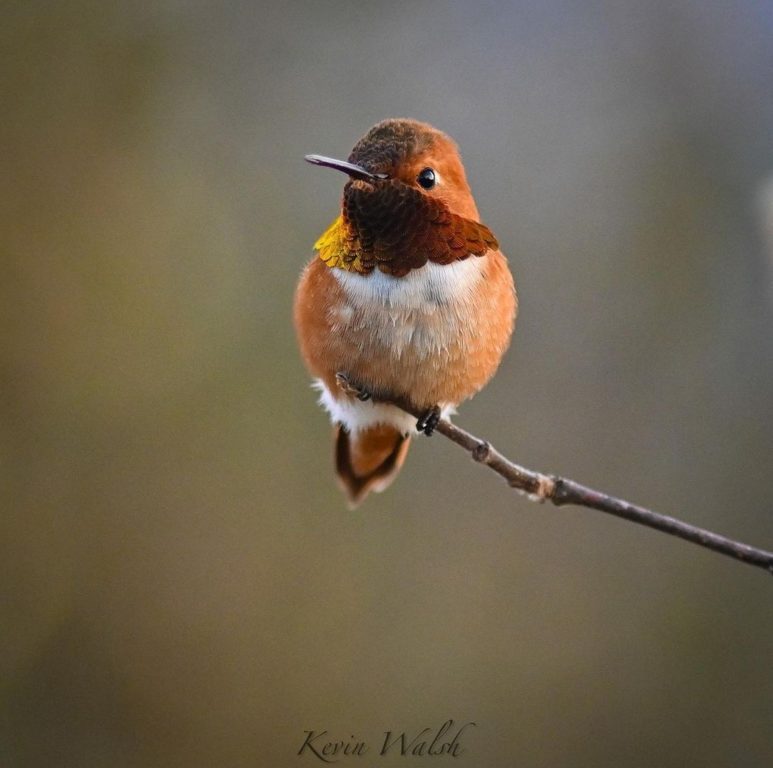
Photo by: Kevin Walsh
Note: The gorget appears chocolate brown in this lighting, however you can still see a glimmer of his iridescent orange-red gorget with some hints of yellow.
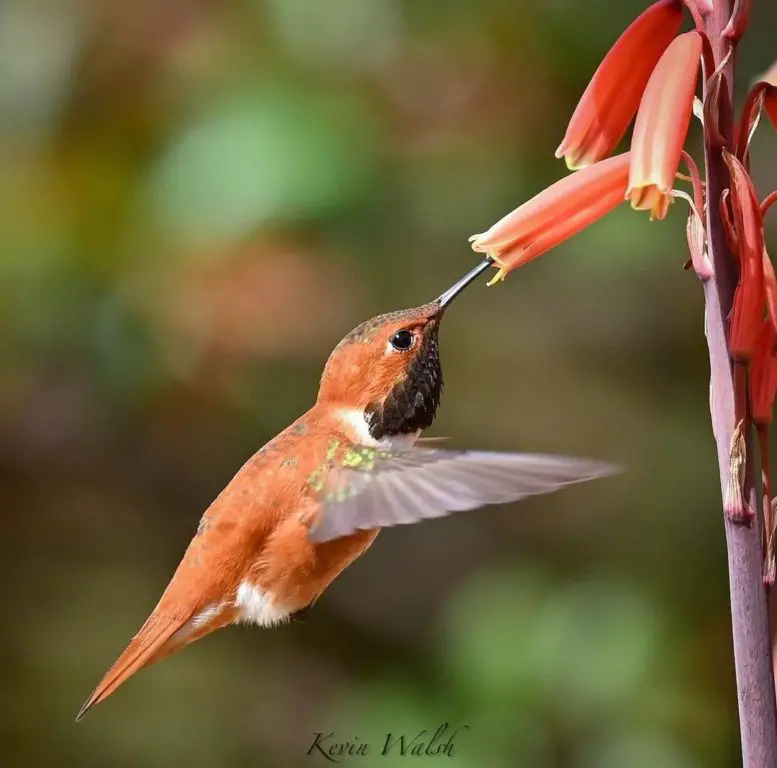
Photo by: Kevin Walsh
Plant: Blue Elf Aloe
Juvenile male Rufous hummingbirds have a rustic look with small iridescent orange specks of color on their throats.
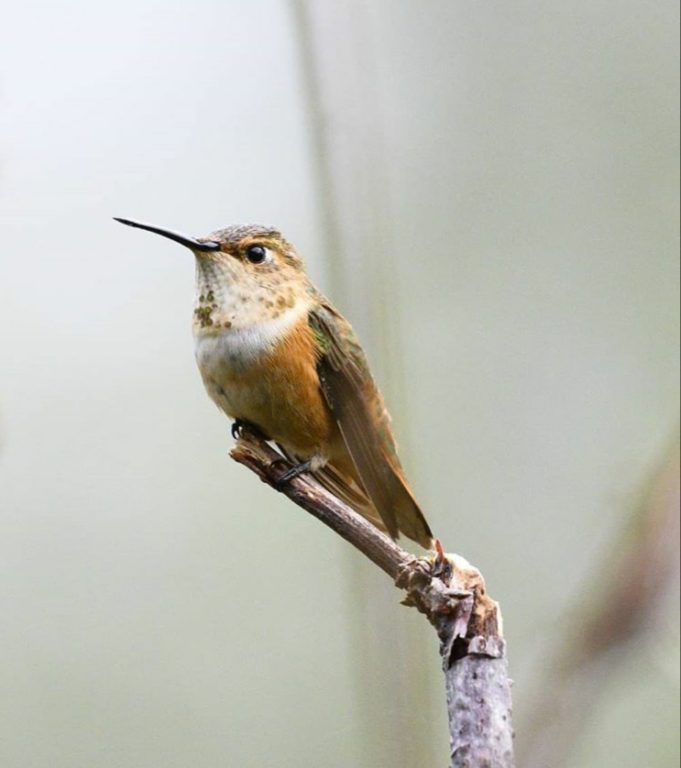
Photo by: jace_the_bird_nerd
Juvenile Rufous hummingbirds are so similar in coloring and temperament to an Allen’s hummingbird that they are practically indistinguishable in the field. Therefore, identification is established by range rather than appearance.
Female Rufous hummingbirds are green and white with some iridescent orange feathers on their throat. Their tail is dark with white tips and an orange-red base. Female Rufous hummingbirds are slightly larger than the males in anticipation of producing offspring.
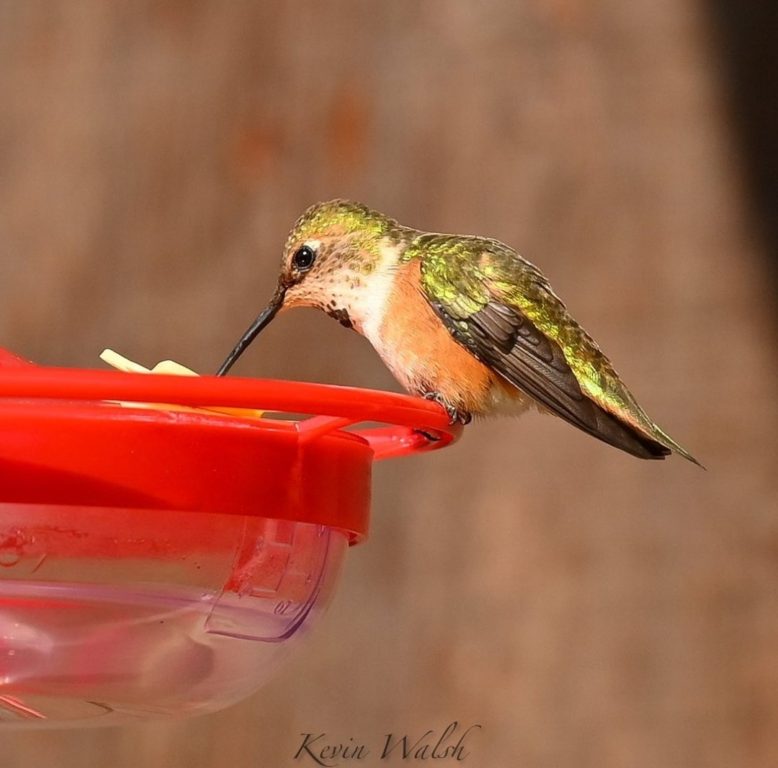
Photo by: Kevin Walsh
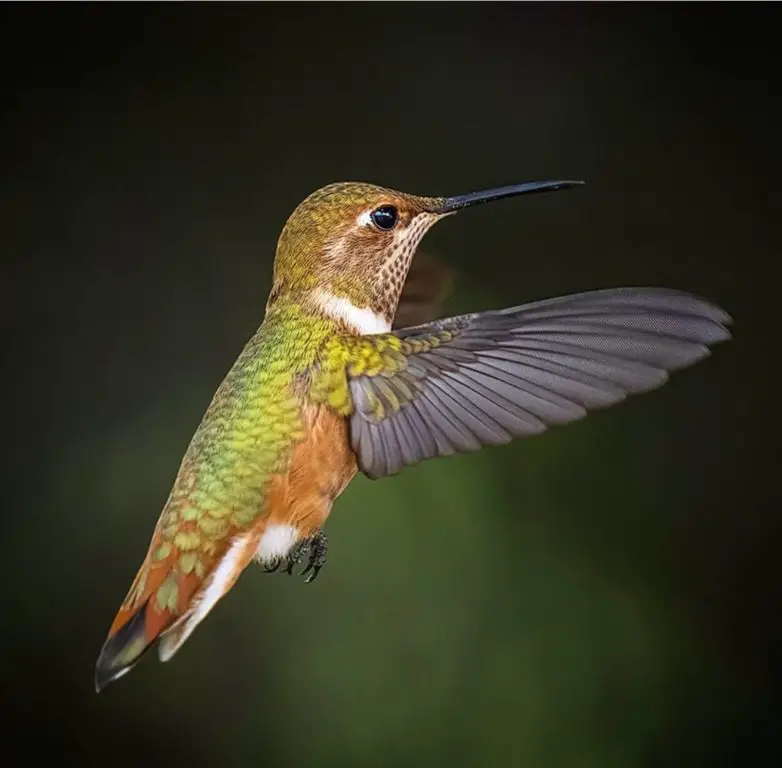
Photo by: sony_alpha_male
Taken: Boise, Idaho
They have one of the northernmost breeding ranges of any hummingbird in the world; migrating north from Mexico and nesting as far north as Alaska to breed during the summer months. They are polygamous and will mate with several partners in a season.
Rufous hummingbirds make the longest migrations of any bird in the world. They travel making a clockwise circuit of western America every year that is approximately 3,900 miles.
Rufous hummingbirds are highly territorial and aggressive towards other hummingbirds and animals. They are fearless and have a reputation for chasing away not only other hummingbirds but even large birds and rodents from their favorite feeders. They have been known to even attack squirrels and chipmunks that come too close to their nest.
Their flying acrobatic skills can outmaneuver all other hummingbird species, making them extremely competitive at feeders.
Rufous hummingbirds have excellent memories and have been known to investigate the location of an old hummingbird feeder years after the feeder has been removed.
During a capture and release banding operation in British Columbia, the oldest living recorded female Rufous hummingbird was 8 years and 11 months old.
See my article: 3 Reasons Why Hummingbirds Are Banded
Due to habitat loss in the Pacific Northwest, Rufous hummingbirds are listed at “near threatened” status by the IUCN red list of threatened species.
See pictures of male, female and juvenile Rufous hummingbirds here…..
Hear sounds of Rufous hummingbirds here…..
Rare/Vagrant Hummingbirds
RUBY-THROATED HUMMINGBIRD – (Archilochus colubris)
Conservation Status: Least concerned
Kingdom: Animalia
Phylum: Chordata
Class: Aves
Order: Apodiformes
Family: Trochilidae
Genus: Archilochus
Species: A. colubris
Ruby-throated hummingbirds are a very rare/accidental bird to Idaho since their main residence is mostly in the Midwest and on the east coast. There has only been one banded and recorded sighting in Idaho.
The Ruby-throated hummingbird’s scientific name originated from Carl Linnaeus, a Swedish botanist, who first listed this scientific classification as “Trochilus colubris”. It’s name changed over a hundred years later and was reclassified by Ludwig Reichenbach, a German botanist to “Archilochus colubris”, which is its current scientific name, meaning “top thief” or “sky spirit/sun-god bird”.
Male Ruby-throated hummingbirds have a striking iridescent blood-red gorget, stopping at the neckline. He is identified with a dull metallic green topside, a light gray underbelly and black wings. The Ruby-throated hummingbird is a smaller species of hummingbirds weighing less than 4.5 grams or 2 U.S. dimes and is 2.8 to 3.3 inches in length. Their lifespan is approximately 3-5 years.
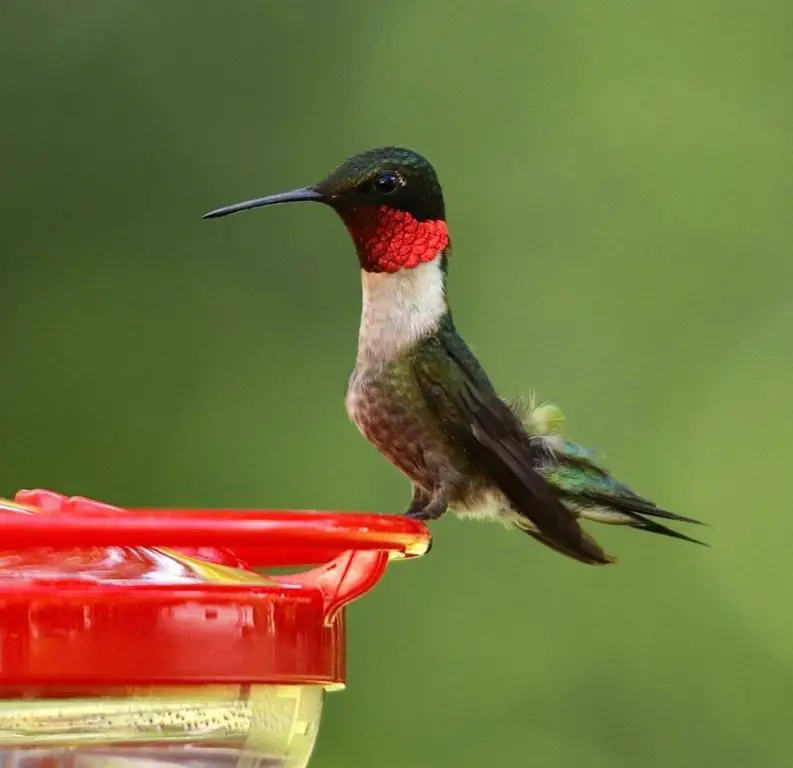
Photo by: dgen.photos
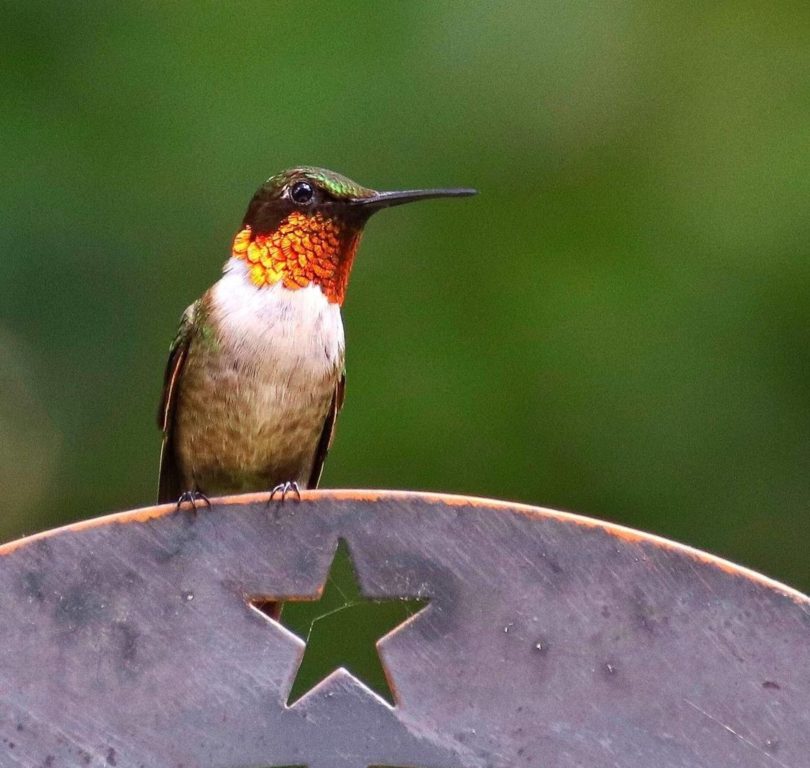
Photo by: paulapaintsart
Female Ruby-throated hummingbirds have a white throat with some light stippling and are typically larger than the males. The oldest female Ruby-throated hummingbird has been recorded at 9 years, almost double that of the male.
However, the average lifespan of a Ruby-throated hummingbird is approximately 3-5 years.
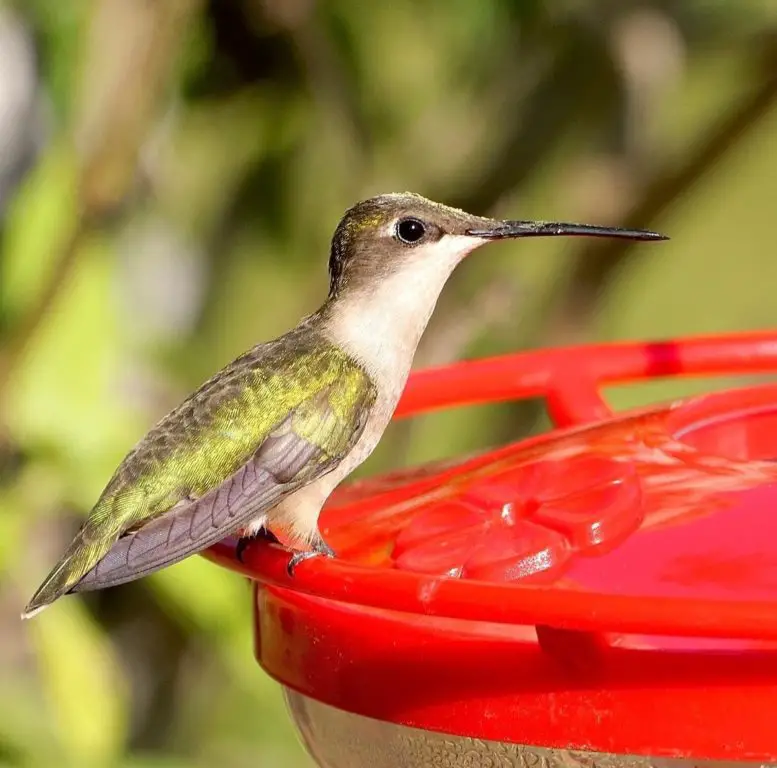
Photo by: dgen.photos
Juvenile male and female Ruby-throated hummingbirds during their initial stages of life resemble their mother exhibiting a white throat with light stippling.
As the males mature, they begin to display a few specks of color near their neckline and eventually their bolder red throat feathers become more dominant and stately displaying a colorful gorget.
Juvenile females show a light faint grey stippling on their throat. As both sexes mature their less vivid and lighter colored plumage will begin to mature and become darker in color.
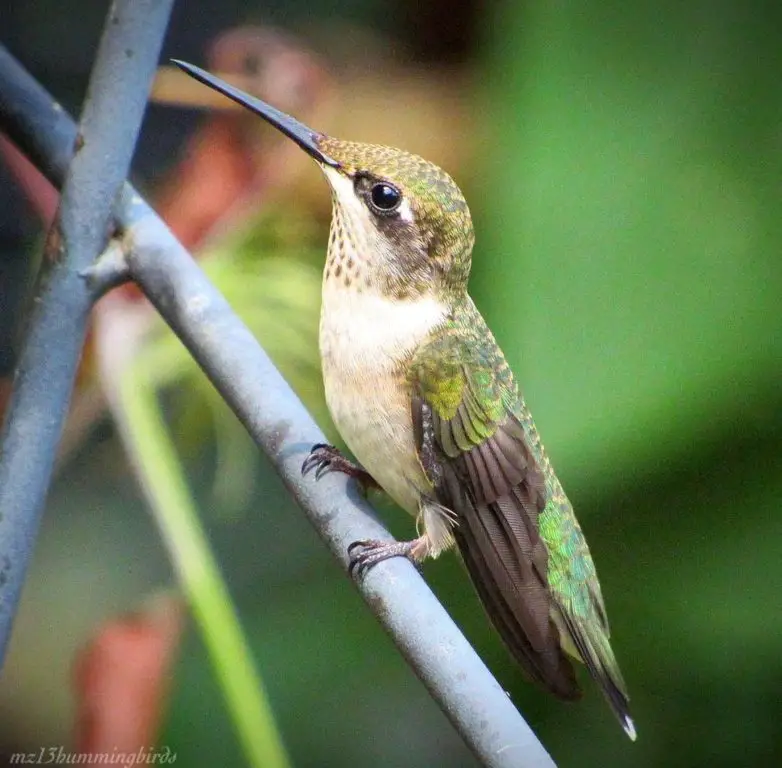
Photo by: mz13hummingbirds
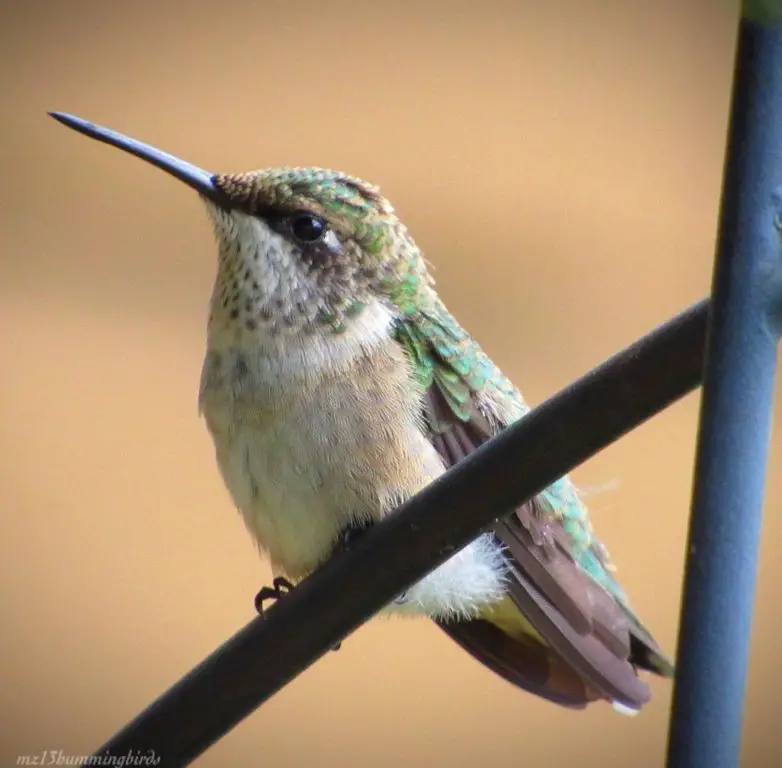
Photo by: mz13hummingbirds
Note: The newly white fluffy down feathers on this baby/juvenile Ruby-throated hummingbird’s bottom. Also notice the nice fat reserves they have accumulated by being fed by their diligent mother which will sustain it through adolescence.
Ruby-throated hummingbirds prefer open woodlands and are often seen in parks, gardens, and backyards. They are solitary birds except during mating periods when they are fiercely territorial and aggressive towards hummingbirds of other species.
Even though these hummingbirds have an aggressive side they can still be eaten by predators such as large invertebrates, praying mantises, orb-weaver spiders, and dragonflies.
See pictures of male, female, and juvenile Ruby-throated hummingbirds here…..
Hear sounds of Ruby-throated hummingbirds here…..
BROAD-BILLED HUMMINGBIRD – (Cynanthus latirostris)
Conservation Status: Least concerned
Kingdom: Animalia
Phylum: Chordata
Class: Aves
Order: Apodiformes
Family: Trochilidae
Genus: Cynanthus
Species: C. latirostris
Broad-billed hummingbirds are a rare sighting in Idaho although they travel frequently to the United States near the southern Mexican border. There has been only one documented banded sighting in Caldwell, Canyon County in 2004.
Male Broad-billed hummingbirds feature a bright blue-green gorget that spreads back towards its shoulders. Juvenile males show off a full charcoal dark grey body with flecks of metallic blue on their throat and a light green neck and backside. They sport a long beak that is bright orange-red accented with a signature black tip. Their size ranges from 3.25 inches to 4 inches in length and weighs 3-4 grams.
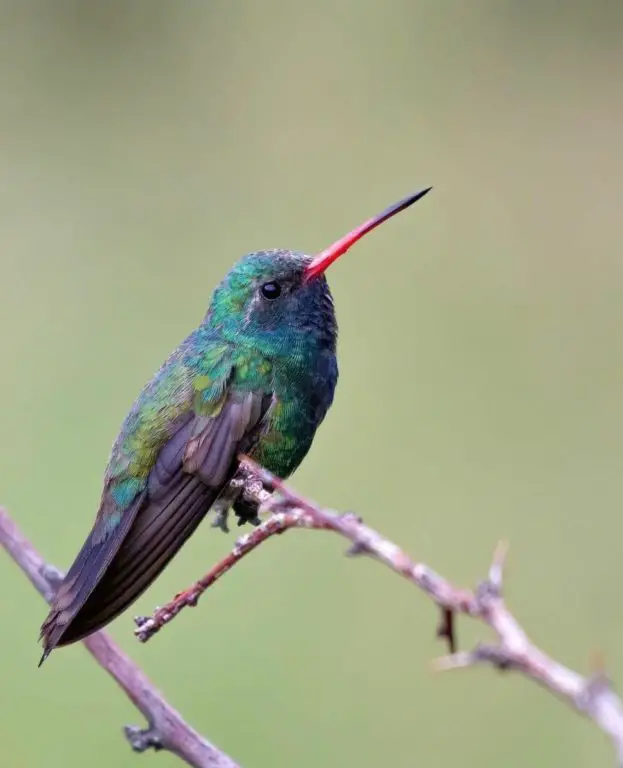
Photo by: Aaron Gomperts
Female Broad-billed hummingbirds are identified with a completely dark bill and a longer white accent above the eyes.
Juvenile male and female Broad-billed hummingbirds are both predominantly metallic green on their topside with a white underbelly. Their tails are dark in color and forked.
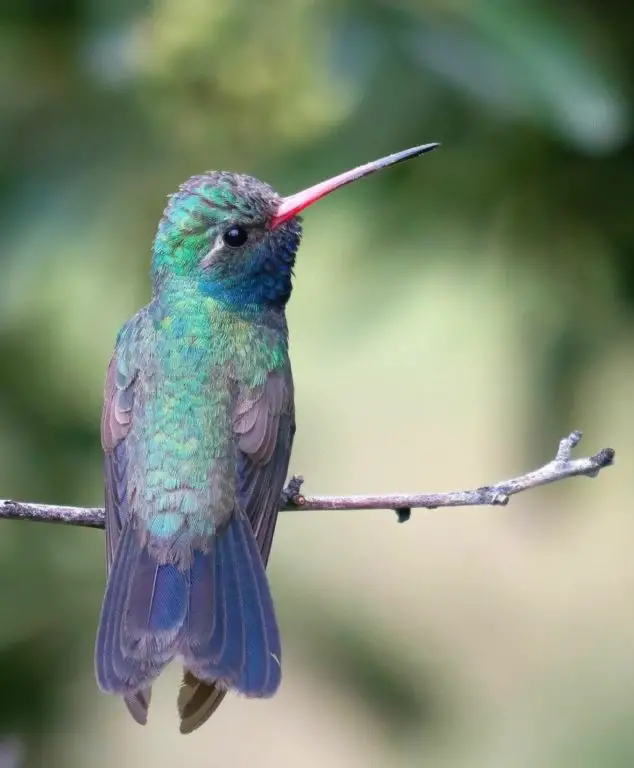
Photo by: Aaron Gomperts
Broad-billed hummingbird nests are distinguishable because they do not decorate the outside of their nests with lichens but instead choose to construct their nests with outside grass fibers, bits of leaves and bark while using spider webs to glue and hold the nest together. The nest that the female builds hangs on a single long slender branch.
Astonishingly, unlike other hummingbird population counts, the Broad-billed hummingbird has shown an actual general population increase in recent years.
The oldest recorded male Broad-billed hummingbird was 9 years and 1 month old when he was captured and released from a banding operation.
See my article: 3 Reasons Why Hummingbirds Are Banded
See pictures of male, female, and juvenile Broad-billed hummingbirds here…..
Hear sounds of Broad-billed hummingbirds here…..
COSTA’S HUMMINGBIRD – (Calypte costae)
Conservation Status: Least concerned
Kingdom: Animalia
Phylum: Chordata
Class: Aves
Order: Apodiformes
Family: Trochilidae
Genus: Calypte
Species: C. costae
Costa’s hummingbirds are an extremely rare/accidental visitors to Idaho since there has only been 1 banded sighting recorded.
Costa’s hummingbird was named in 1839 by Jules Bourcier to commemorate Louis Marie Pantaleon Costa, the French ornithologist who was an avid collector of hummingbirds.
Male Costa’s hummingbirds have a bright reddish-purple cap and gorget. Their gorget has long streaming throat feathers, similar to a Calliope hummingbird. Having green backs and flanks, their back and wings are black and their throat and tail have patches of white. Their size ranges from 3 inches to 3.5 inches in length and weighs 2-3 grams.
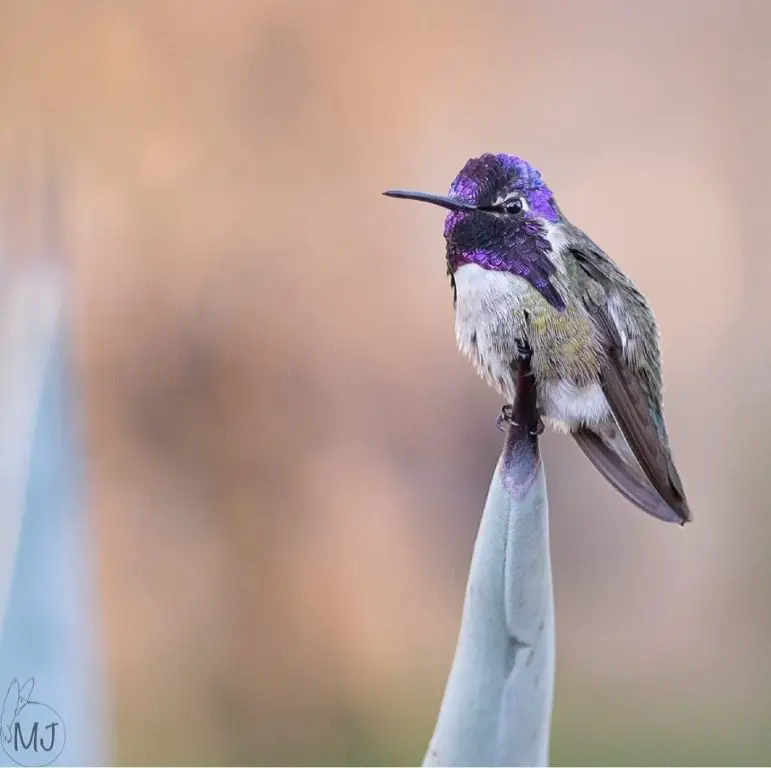
Photo by: hummingbirdsbysuprise
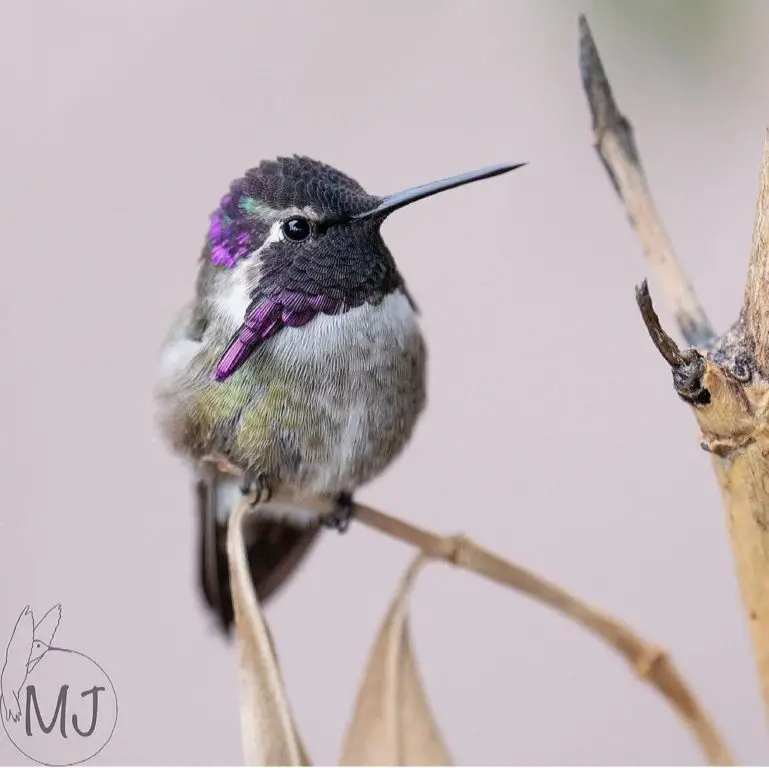
Photo by: hummingbirdsbysuprise
Female Costa’s hummingbirds are not as vibrant and display in color, a grayish-light green back with a dusty white underbelly.
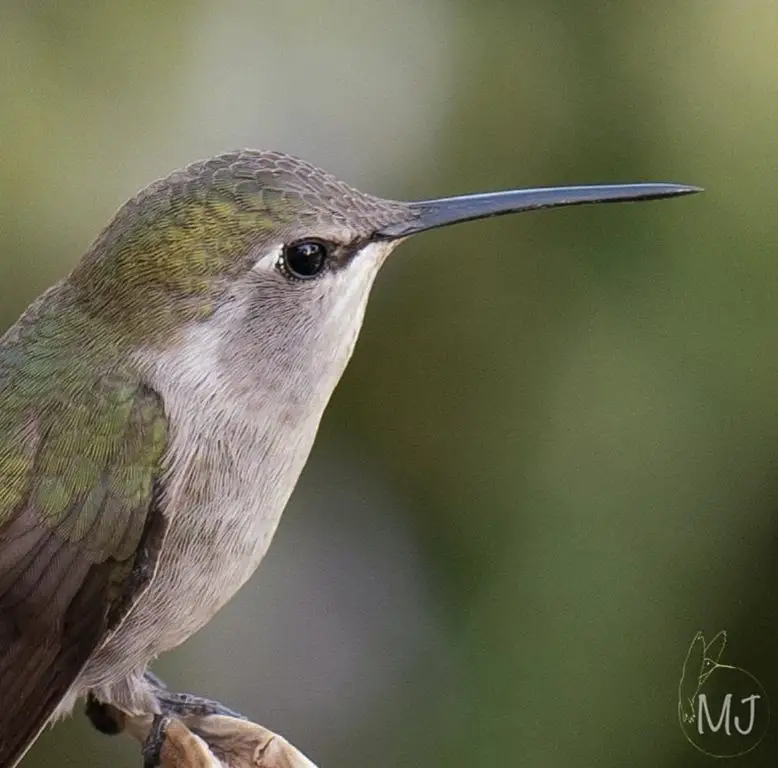
Photo by: hummingbirdsbysuprise
Female Costa’s hummingbirds migrate north to breed. They are a desert-dwelling species and build their nests in open areas with scarce vegetative cover. They have been known to nest on the tops of cacti. The thorns of the plant act as a deterrent to predators that may attempt to eat the eggs or nestlings.
Their habitat consists of desert scrub and washes including grasslands where they thrive on desert plants or ocotillos.
Male Costa’s hummingbirds are extremely territorial and can come across as being the meanest sheriff in town, especially when defending “their” feeders. Their aggressive conduct is equivalent to the known quarrelsome and combative behaviors of the Rufous hummingbird.
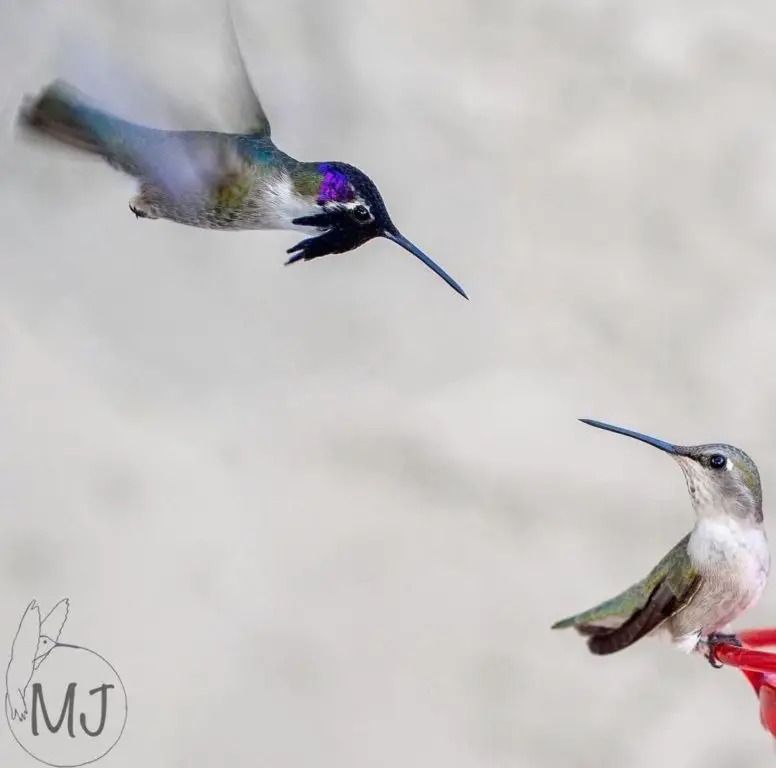
Photo by: hummingbirdsbysuprise
These hummingbirds have no known predators, however, the largest threat to Costa’s hummingbirds is human encroachment in the form of the desert being plowed and cleared for settlement and grazing.
They are known to interbreed and produce hybrids between Anna’s and Black-chinned hummingbirds.
See pictures of male, female and juvenile Costa’s hummingbirds here…..
Hear sounds of Costa’s hummingbirds here…..
See my article: Hummingbird Migration in Idaho
Happy Hummingbird Watching!
Backyard Visitors participates in affiliate programs which compensate us for referring traffic.

